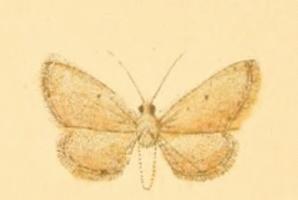
The tawny speckled pug is a moth of the family Geometridae.

Eupithecia venosata, the netted pug, is a moth of the family Geometridae, first described by the Danish zoologist Johan Christian Fabricius in 1787. It is found across the Palearctic realm from Portugal and Morocco in the west to the Lake Baikal in Siberia and Afghanistan and Pakistan in the east.

Eupithecia breviculata is a moth of the family Geometridae. It is found in the Mediterranean region, Switzerland, Hungary, the Near East and North Africa. It is also found in Iran and Turkmenistan.

Eupithecia distinctaria, the thyme pug, is a moth of the family Geometridae. It is found throughout Europe. It is also found in Iran. from the Iberian Peninsula through western and central Europe including the British Isles as well as further east as far east as far as Russia and Iran. In the north the range reaches as far as the southern Fennoscandia, to the south, where it is more common, it occupies the Mediterranean and Asia Minor. It is found primarily on warm, stony slopes and rocky structures as well as on sparse grassy areas with thyme mounds. In the Alps, it rises to heights of 2000 metres.
Eupithecia rajata is a moth in the family Geometridae. It is found from the southern Himalaya to south-western China (Yunnan), Myanmar and Thailand.
Eupithecia obtinens is a moth in the family Geometridae. It is found in Afghanistan and Iran.
Eupithecia parallelaria is a moth in the family Geometridae. It is found in Turkmenistan, Iran, eastern Afghanistan and Kashmir.
Eupithecia xanthomixta is a moth in the family Geometridae. It is found in Afghanistan and Iran.

Eupithecia fuscicostata is a moth in the family Geometridae. It is found in Romania, North Macedonia and Greece, as well as the Near East and Iran.
Eupithecia gratiosata is a moth in the family Geometridae. It is found in France, the Iberian Peninsula, Italy, the Balkan Peninsula, Ukraine, Poland, Russia, Turkmenistan, Kazakhstan, the Near East and Iran.
Eupithecia limbata is a moth in the family Geometridae. It is found in Italy, France, Slovenia, North Macedonia, Greece and Bulgaria. It is also found in Iran.

Eupithecia sutiliata is a moth in the family Geometridae. It is found in south-eastern Russia and Mount Chelmos in Greece. It is also found in Iran.
Eupithecia tenellata is a moth in the family Geometridae. It is found in North Africa, Iran and the Arabian Peninsula.
Eupithecia mesogrammata is a moth in the family Geometridae. It is found in Iran, Turkey and Georgia.
Eupithecia lithographata is a moth in the family Geometridae. It is found in Iran.
Eupithecia novata is a moth in the family Geometridae. It is found in Iran and Turkey.
Eupithecia cheituna is a moth in the family Geometridae. It is found in Iran.
Eupithecia opistographata is a moth in the family Geometridae. It is found in Turkmenistan, Iran, Pakistan and China.
Eupithecia prouti is a moth in the family Geometridae. It is found in Iran.
Eupithecia eduardi is a moth in the family Geometridae. It was described by Vladimir G. Mironov and Ulrich Ratzel in 2012 and it is found in Iran.





